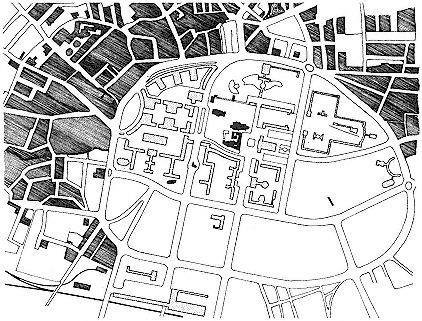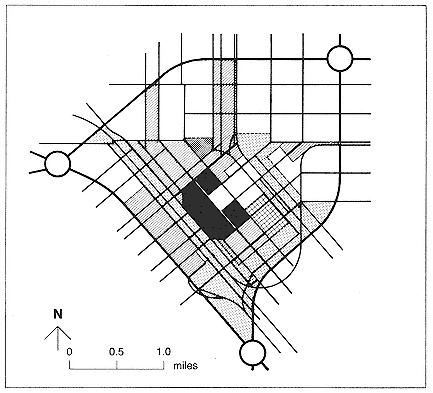The Functionalist Stance
Of the four orientations we examine here, functionalism, with the longest history, has been the most comprehensively outlined. Its origins are in the Bauhaus and the work of Le Corbusier; its credo is the Athens
Charter of the Congrès Internationaux d'Architecture Moderne (CIAM),[*] issued in 1933. Workability and competence are its goals. It is the equivalent in urban planning of the modern movement in architecture. This is not to say that the functionalist view is consistent. It originated in the 1920s and dominated design theory into the 1950s, evolving in response to criticism and changing conditions. In part because of such periodic corrections, we prefer the terms stance or orientation to the more specific term theory . A theory of urban design needs to describe the nature of urban settings, the goals for urban form and use, and a method for realizing the goals that is consistent with the nature of the settings. A stance is similar but less precise. It points to a constellation of individuals with similar values, among whom there can nonetheless be considerable differences of opinion and emphasis.
Functionalism envisions the city as a collection of uses to be accommodated: residence, work, leisure, and the traffic systems that serve them. In early functionalist thought the city was characterized as a machine, in later thought, as a complex organism and as a network or constellation of community centers linked to and directed by a central core.[1] A functionalist city is equitable; it does not favor or neglect social groups. Everyone benefits from adequate sunlight, fresh air, and access to open space.
Functionalist theory treats residence, work, and leisure as discrete elements. Activities should not mix; hence zoning is a key element of the functionalist city, for in a zoned environment, activities can proceed with little or no interference from other activities. In functionalist urban planning, organizing functional relations in a two-dimensional plan usually takes precedence over organizing other relations. The graphics associated with each of the four orientations are telling: functionalist schemes rely heavily on plan drawings, whereas humanist, systemic, and formalist schemes are typified, respectively, by intimate views, diagrams, and bird's-eye perspectives.
Though functionalist theory calls for the separation of activities, in one locale, the heart or core of the city, these must be commingled. The idealized purpose of the urban center is "to enable people to meet one another to exchange ideas." Therefore that center "must be attractive to all types of people in the region it serves"—a place of rendezvous, spontaneity, organized activity, refuge. In sum, the urban center should engender "civic consciousness."[2] It is more than a machine for making money and more than a crossroads for traffic and goods: "The Core includes other elements, often of an imponderable nature."[3] Necessary to the success of the urban center is the absence of vehicular traffic, for the urban center is the domain of pedestrians.
Though not a feature of its dogma, orthogonal planning characterizes most functionalist urban design. Schemes tend to mix formal and asymmetrical elements in a visual treatment that seems all of a piece because of the underlying rectilinear format. This admixture seems to satisfy a fur-
[*] CIAM, founded in 1928, formalized and proselytized the precepts of modern architecture.

7.
In the ideogram summarizing the functionalist stance, orthogonal planning is
set within the organic framework of the medieval city.The grain of the functionalist
plan is regular and includes muchopen space. Based on a plan for Coventry,
England, published in Architect and Building News, 21 March 1941.
ther functionalist goal—that contemporary towns exhibit contemporary (constructivist, cubist) means of expression.[4]
The quality of functionalist design depends on how competently it accommodates needs and activities and on how well it uses light, space, and greenery, the ingredients of an urban plan that enhance daily experience. Open space is highly valued—not vast spaces but controlled, demarcated spaces adjacent to functional areas. This value may be seen as a reaction to crowded conditions in medieval towns and nineteenth-century industrial cities.
Functionalist theory calls for research, a thorough analysis of needs and circumstances, and a deliberative decision-making process by trained professionals. They must coordinate natural, sociological, economic, and other factors specific to the cultural context and stage of development. Planning anticipates rather than responds: "Intelligent forecasts will have sketched its future, described its character, foreseen the extent of its expansions, and limited their excesses in advance."[5]
Whereas functionalist thinking is associated with Le Corbusier and CIAM, Constantine Doxiadis's later ekistic theory may be seen as a "correction" and elaboration of that tradition. Ekistic principles include (1) being realistic; (2) thinking at long range and with broad scope; (3) identifying, evaluating, and classifying problems to be addressed; (4) establish-
ing policies to guide decisions; (5) devising plans that follow from those policies; (6) evaluating constantly; and (7) reappraising periodically.[6]
According to the functionalist view, historically significant buildings should be preserved for their educational value, but the layout of historic districts should not be the basis for planning contemporary towns. Urban developments that occurred by chance or grew from particular historical imperatives are notorious for their inhumane living conditions. Medieval precincts of cities and industrial slums are evidence of inadequate methods for urban development.
Critics of functionalism argue that it deals with urban design only impersonally, at a large scale: "A land-use master plan for a big city is largely a matter of proposed placement, often in relation to transportation, of many series of decontaminated sortings."[7] The human scale is often neglected. Then, too, the general categories that functionalism considers, like residence and traffic, fail to acknowledge subtleties. In fact these variables may well be the wrong ones to begin with in urban design, for they do not take into account "the personality of the inhabitants" and are "too often inhuman."[8] The functionalist vision is "negative" because "it con-

8.
Typical functionalist land use plan.
Derived from a Victor Gruen scheme for Fresno, California.
ceives of buildings merely as scaffolding for functional variations, abstract containers that embody whatever functions successively fill them."[9] Separation and zoning may ameliorate nuisance and the interference of functional parts, but such a division of activities also works against richness. The hustle and bustle of downtown, or of a neighborhood center, are impossible when uses are sorted out and treated in standardized ways: "A hierarchy of human associations should replace the functional hierarchy of the Charte d'Athènes ."[10]
Functionalist designers are accused of responding to superficial and ephemeral wants, fashions, and pressures rather than to long-standing cultural traditions. For some critics this concern with the transitory is a manifestation of bourgeois, capitalist culture: "The vulgarity of late capitalist architecture is as much caused by the random profusion of building types as by the endless invention of building materials and construction systems; [it is] not an outcome of rationalisation but of maximisation of profits."[11]
Finally, the singlemindedness of the functionalist stance threatens to overwhelm regional and cultural differences. Functional analysis describes rather than explains the city: "It does not posit any element of continuity between the genre de vie and the urban structure."[12] "We are willing to accept functional classification as a practical and contingent criterion, the equivalent of a number of other criteria—for example, social make-up, constructional system, development of the area, and so on—since such classifications have a certain utility; nonetheless it is clear that they are more useful for telling us about the point of view adopted for classification than about an element itself."[13]